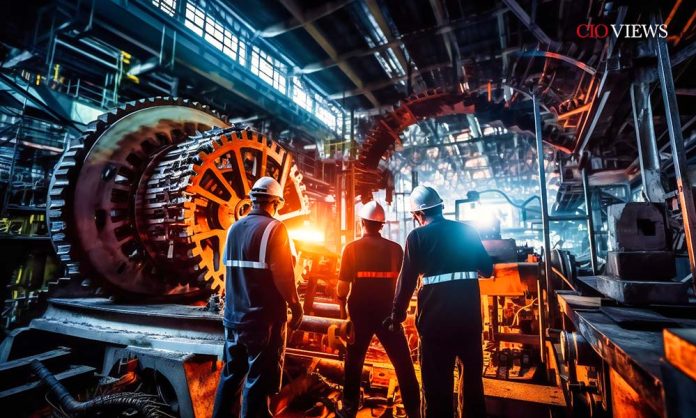
The manufacturing industry is undergoing a profound transformation in 2024, marked by the rapid advancement of Industry 4.0 technologies, unprecedented supply chain disruptions, and critical workforce shortages. To thrive in this dynamic environment, manufacturers must navigate through a myriad of challenges in the manufacturing industry.
1. Industry 4.0 Transformation
Industry 4.0, characterized by the fusion of digital technologies with traditional manufacturing processes, presents both opportunities and challenges. To leverage the benefits of automation, artificial intelligence, and the Internet of Things (IoT), manufacturers must embrace digital transformation strategies.
- Implement predictive maintenance systems to optimize equipment performance and minimize downtime.
- Integrate AI-driven analytics to enhance decision-making processes and improve operational efficiency.
- Invest in employee training programs to equip workers with the skills needed to operate and maintain advanced technologies.
2. Supply Chain Disruptions
This is the major challenges in the manufacturing industry. The COVID-19 pandemic exposed vulnerabilities in global supply chains, exacerbating existing challenges such as geopolitical tensions and natural disasters. To mitigate the impact of disruptions, manufacturers must adopt agile and resilient supply chain strategies.
3. Technology Integration Challenges
Integrating new technologies into existing manufacturing processes is a complex endeavor that requires careful planning and execution. Manufacturers must overcome compatibility issues, legacy systems, and cultural resistance to drive successful digital transformations.
- Conduct comprehensive assessments of existing infrastructure and capabilities to identify potential integration challenges.
- Prioritize investments in interoperable technologies and scalable solutions to facilitate seamless integration.
- Foster a culture of innovation and collaboration to encourage experimentation and adoption of new technologies.
4. Workforce Shortages
The manufacturing industry is facing a shortage of skilled workers, driven by factors such as an aging workforce, demographic shifts, and inadequate training programs. To address this challenge, manufacturers must invest in talent development initiatives and adopt strategies to attract and retain top talent.
- Partner with educational institutions and vocational training programs to develop tailored workforce development initiatives.
- Offer competitive wages, benefits, and career advancement opportunities to attract and retain skilled workers.
- Embrace diversity and inclusion initiatives to create a more inclusive and equitable workplace culture.
5. Some Other Challenges:
Labour Shortage
As Baby Boomers leave the workforce and openings made conceivable by innovation fuel development, it’s normal that about 4.6 million assembling occupations will wind up accessible throughout the following decade – and almost 2.4 million are relied upon to go unfilled. Today, 6 out of 10 open talented generation positions are unfilled. While mechanization and mechanical technology may help fill the work hole, talented specialists will, in any case, be expected to apply critical thinking abilities, perform investigation and oversee creation. One reason makers are thinking that its hard to fill positions, both talented and incompetent, is the absence of exchange school open doors for young fellows and ladies. To tackle this issue, numerous producers are creating powerful preparing projects to show hopefuls everything from the pass on making and welding to mechanical technology programming and sheet rolling.
Cybersecurity
As technology propels, so do the endeavors and abilities of cybercriminals. While ransomware was previously the most widely recognized type of cybercrime, following quite a while of wild development it’s been overwhelmed by two “new” dangers: banking trojans and crypto miners. Most producers are depending on obsolete security frameworks unequipped for tending to the number and intricacy of dangers today, leaving huge numbers of them helpless against exorbitant ruptures. Organizations need to utilize increasingly refined methods for verifying their systems, as the customary firewall approach may not be satisfactory to shield programmers from getting to them and doing genuine harm.
Global Competition
Today, as per the Global Manufacturing Competitiveness Index, the U.S. does not hold the top spot as the world’s most aggressive economy; China has that respect, however, it’s normal that we’ll take that spot by 2020. What it will take to get and hold that spot, as indicated by a report by Deloitte, The Future of Manufacturing, are cutting edge innovations and ability – with ability being viewed as the top driver for intensity.
The report recommends that for makers to be aggressive later on, they should move creation to a higher esteem, cutting edge innovation items and procedures, to some degree to dodge value wars, and to a limited extent to make it conceivable to offer the new item as an administration and administration based estimating models.
Qualified Leads
Traditional marketing endeavours for producers are demonstrating far less successful than previously; expos, exchange advertisements and cold calls aren’t working like they used to. In the computerized age, associations need to accomplish more than set up a site and expectation that their best prospects will unearth it. Modern B2B advertisers need to try to be found naturally through online inquiries and give an abundance of data that shows importance and mastery. That implies they have to use inbound promoting and SEO strategies by making content that gives answers to potential clients’ inquiries and issues.
In conclusion, the manufacturing industry of 2024 is facing unprecedented challenges that require innovative solutions and strategic foresight. By embracing digital transformation, fostering resilience in supply chains, overcoming technology integration barriers, and investing in talent development, manufacturers can position themselves for success in an increasingly competitive and volatile landscape.




















